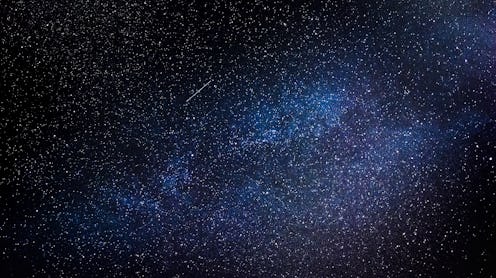Life
A Huge Asteroid Will Fly Close To Earth This Month, But Don't Freak Out Yet
Another day, another asteroid hurtling toward Earth on a path that takes it far too close for comfort. Later in April, Earthlings with telescopes might be able to catch the closest flyby of a big asteroid since 2004 (when the potato-shaped asteroid Toutatis scooted by less than one million miles away from Earth) — and the closest flyby of this particular asteroid in 400 years. The asteroid in question has a rather less poetic name than its 2004 predecessor: 2014 JO25.
According to NASA’s Jet Propulsion Laboratory, asteroid 2014 JO25 will pass by our planet nearly 1.1 million miles away, or about 4.6 times the distance between Earth and the moon, on Apr. 19. It’s a perfectly safe distance: NASA writes that there’s “no possibility for the asteroid to collide with our planet” — so you can pause your doomsday preparations.
What makes the flyby notable, however, is the asteroid’s size. Smaller asteroids regularly orbit past Earth at similar distances, but at roughly 2,000 feet wide, 2014 JO25 is a fairly large asteroid to be passing by so close to the planet. In fact, Apr. 19 will mark the closest approach of an asteroid this size or larger since Toutatis' flyby in 2004. The next known encounter isn't calculated to take place until 2027, when a half-mile-wide asteroid named 1999 AN10 will pass by Earth about 236,000 miles away. You'd think space rocks would have a better concept of personal space.
Again, though, there's not much worry about there; NASA's Near Object Earth program writes that the probability of impact with 1999 AN10 is "essentially zero."
But back to the asteroid due to fly by Earth in April 2017. According to EarthSky, the asteroid was discovered in 2014 by astronomers at the Catalina Sky Survey in Arizona. Although researchers have calculated its size and reflective properties (about twice as reflective as the moon), not much else is known about 2014 JO25's physical attributes. However, its orbit is well-understood. Apr. 19's encounter will be the closest the asteroid has come to Earth in 400 years, and it won't swing by this close again for 500 more. This might be astronomers' best chance to study the asteroid, so radar and telescopic observations have been planned around the world.
2014 JO25 will approach our planet from the direction of the sun, and it's anticipated to reach magnitude 11 in brightness. That's not visible to the naked eye, but it's possible to catch sight of the asteroid with a small telescope. According to EarthSky, it'll be closest to Earth on the morning of Apr. 19, but a skywatcher's best bet is to wait until nightfall to look for the asteroid, which will appear as a slow-moving star in the northern sky.
While you're at it, keep an eye out for panSTARRS, a comet puttering its way across the southern sky. It'll make its own close approach to Earth on Apr. 19, and in early April, it abruptly brightened in an outburst. So even if you don't have a telescope, break out your binoculars and you can still enjoy the sight of April's busy night sky.
